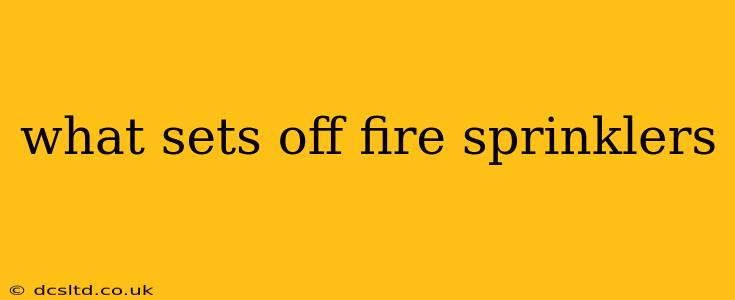What Sets Off Fire Sprinklers? Understanding the Activation Process
Fire sprinklers are life-saving devices designed to suppress and extinguish fires before they escalate into major disasters. But what exactly triggers these vital systems? The short answer is heat. However, the process is more nuanced than simply reaching a certain temperature. Let's delve deeper into the mechanisms that set off fire sprinklers.
What Temperature Do Fire Sprinklers Go Off At?
This is a common question, and the answer is: it depends. Sprinklers are designed with specific temperature ratings, typically ranging from 135°F (57°C) to 500°F (260°C) and higher for specialized applications. The appropriate temperature rating is selected based on the fire risk of the location. For example, a kitchen might use a higher-temperature sprinkler than an office space. The sprinkler head itself contains a heat-sensitive element that melts or activates at its predetermined temperature, releasing water.
How Do Fire Sprinkler Heads Work?
Most fire sprinkler heads utilize a glass bulb or a frangible bulb. Inside this bulb is a liquid that expands when heated. Once the liquid reaches a critical temperature (the sprinkler's rating), the bulb breaks, releasing a small amount of pressure that opens the sprinkler head and allows water to flow. Other types of sprinkler heads use different heat-sensitive mechanisms, but the basic principle remains the same: heat triggers a release mechanism that activates the water flow.
What Other Things Can Set Off Fire Sprinklers?
While heat is the primary trigger, there are some less common scenarios that can potentially activate fire sprinklers:
- Mechanical Damage: Accidental damage to the sprinkler head, such as a hard impact or forceful pressure, can cause it to discharge.
- Water Hammer: Sudden pressure surges in the water supply lines can, in rare cases, cause a sprinkler to activate. This is less common in well-maintained systems.
- Improper Installation: Incorrect installation or inadequate maintenance can lead to premature activation.
- Manufacturing Defects: While rare, manufacturing defects in the sprinkler head itself could cause unintended activation.
Can a Small Fire Set Off a Sprinkler?
Yes, a small fire can set off a sprinkler, depending on the proximity of the fire to the sprinkler head and the temperature rating of the sprinkler. Remember, sprinklers are designed to activate locally. This means only the sprinklers closest to the fire will activate, not the entire system. This localized response helps to minimize water damage while still effectively controlling the fire.
What Causes False Alarms in Fire Sprinkler Systems?
False alarms are infrequent but can be caused by several factors, including:
- High ambient temperatures: Unusually high room temperatures (not necessarily a fire) could potentially cause sprinkler activation, especially in areas with inadequate ventilation.
- Construction or Maintenance Activities: Work near sprinkler heads could unintentionally damage or activate them.
- Improper Maintenance: Lack of regular maintenance checks can lead to undetected leaks or malfunctions.
Understanding how fire sprinklers work is crucial for fire safety. Remember that these systems are designed to protect lives and property and are a vital component of any comprehensive fire safety plan. Regular inspection and maintenance are essential to ensure their proper functioning and prevent unintended activation.
